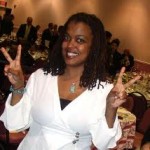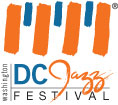In this pinched economic atmosphere, one which has been further constricted by a DC city administration that doesn’t appear as favorably disposed towards the event as in the past (unfortunately no Jazz on the Mall free extravaganza this year), the DC Jazz Festival kicked off its 8th annual edition June 1 very favorably. Swimming mightily upstream against the tide of tight economics, festival founder and Executive Producer Charlie Fishman and hard-working Executive Director Sunny Sumter kept tight upper lips and went about the business of building a mighty rainbow coalition of presenting entities ranging literally across the DC community. In so doing they’ve positioned this festival as a model of community coalition-building and cooperative effort the likes of which seems quite unprecedented in the jazz festival community.

Vocalist Sunny Sumter is the Executive Director of the DC Jazz Festival
Certainly there are other jazz festivals which have built sturdy community coalitions to broaden the artistic reach and audience development of their events. Two such festivals that come immediately to mind are the Discover Jazz Festival, which has done a marvelous job of building a big tent atmosphere that welcomes a coalition of restaurants, bars and grills, and municipal spaces under the big top to literally take over their lovely, compact Burlington, VT community sitting on the banks of Lake Champlain. A big city example in this country would have to be Earshot Jazz, which has done likewise in Seattle. But all too often the attitude is one of suspicious competition; as is the case with certain festivals whose most significant year-round jazz venues cast a sidelong glance at the festival in question, offer lip-service and grudging support, but continue to operate under a veil of jealousy owed to the wrong-headed notion that since the festival is presented by a not-for-profit and is subject to grant support which the year-round venue (a for-profit) isn’t privy to, that they are somehow competitors. Such is the plight of jazz presenting, which for about the last 40 years has uncomfortably straddled the fence between its for-profit, club-based venue system and the newer not-for-profit model that has arisen along with the development of the National Endowment for the Arts and various community arts funding systems. Seems some for-profit venues just don’t get it, that mutual support is to the ultimate benefit of the music, the musicians, and more importantly the local audience, since jazz audience development is job #1; that this is NOT a competition for butts in the seats, but instead should be a hand-in-glove, mutual cooperation society.
But back to the DC Jazz Festival. Where jazz presenting is concerned, the nation’s capital region – and in this case I’m considering the District, Maryland, and Northern Virginia – is blessed with some very significant concert presenters who regularly include jazz in their varied menus. That equation begins with the Kennedy Center, Washington Performing Arts Society, the two gorgeous bordering Maryland venues, the Clarice Smith Center (University of Maryland in College Park with four separate venues) and Strathmore Music Hall (Rockville, with its intimate Mansion space and large concert hall), and to a lesser extent Lisner Auditorium (George Washington University), the Smithsonian (including fostering April as Jazz Appreciation Month and the annual Sculpture Garden offerings), and occasional Library of Congress offerings (including Larry Appelbaum’s annual curated jazz film series). The community has also been blessed recently with several spiffy new venues, chief among them The Hamilton, the beautifully refurbished historic Howard Theatre, and the comfortable mid-sized Atlas, located in a fast-rising sector of the city’s N.E. corridor. The latter is an auditorium, while the former two might well be characterized as 21st century supperclubs due to their larger-than-club size. Yet it is the club venue marketplace that is the DC Jazz Festival sweetspot.
Charlie Fishman and Sunny Sumter have craftily built a sturdy coalition of local venues that in addition to The Hamilton, the Howard Theatre, and the Atlas, also includes DC’s hottest jazz venue Bohemian Caverns, the Phillips Collection art museum, several Smithsonian facilities, a senior wellness center, and the Kennedy Center to boot. They’ve also incorporated a vibrant scene of sorts which is being developed by two sharp young grassroots jazz enthusiasts under their web-based CapitalBop.com banner (you’ll be able to read more about CapitalBop on this site in a minute). The festival’s partnership with CapitalBop.com has also broadened the event stylistically as the two 20-somethings who comprise CapitalBop.com have an eye towards the adventurous edge of the music, engaging non-traditional venues for their DC Jazz Loft Series component of the festival.

Charlie Fishman is the visionary founder and Executive Producer of the DC Jazz Festival
Some of these, and a raft of other partner venues, contribute to the vibrant heart of the DCJF, their Jazz In the ‘Hoods component which as its name suggests brings a jazz presence to all corners of the District (bringing jazz to 21 DC neighborhoods!). This includes areas east of the Anacostia River, a traditional African American community which had been largely bereft of jazz presentation before arts entrepreneur Vernard Gray stepped up with his series of presentations under the rubric of the East River JazzFest. Houses of worship are part of the equation as well, ranging from Faith Presbyterian Church’s presentation of vibist Warren Wolf‘s “Jazz: A Music of the Spirit” to the Sixth & I Historic Synagogue’s presentation of the Anat Cohen Quartet. Reading the DCJF brochure and web site can be a dizzying exercise, the event is literally chockablock with tasty morsels, and one can barely traverse five blocks in the District without encountering part of the big tent of venues that comprises the DC Jazz Festival.
So far the results of this big tent effect have been very promising, with sell-outs in several venues and the town buzzing with activity. Les Nubians sold out two shows at The Hamilton, following a fine opening evening with Randy Weston‘s African Rhythms Trio and vocalist Akua Allrich. Later this week The Hamilton will host Jimmy Heath & Antonio Hart, Roy Hargrove, Cyrus Chestnut, and what should be a kinetic island show (yes ‘mon) with Monty Alexander & Etienne Charles. Dianne Reeves sold out the Howard Theatre, The Fridge loft space was jam-packed for bassist Kris Funn & Corner Store and Tarbaby (with Orrin Evans, Eric Revis & Nasheet Waits), and Ron Carter‘s Quartet sold out four weekend shows at the Bohemian Caverns. Carter’s ensemble, with Renee Rosnes on piano, was a marvelous display of small group interplay and dynamic color.
Another very positive element of the DCJF big tent presentation equation is the broad stylistic spread of the music, which this year ranges from such masters as Weston, Carter, Kenny Barron, Paquito D’Rivera (the latter three – Barron and Carter as part of the Classical Jazz Quartet with Stefon Harris and Lewis Nash – in a stellar Kennedy Center concert titled Jazz Meets the Classics last evening at the Kennedy Center), and Jimmy Heath to John Scofield at The Hamilton, Dianne Reeves, David Sanchez, Mark Turner, Roy Hargrove, Cyrus Chestnut, Marcus Strickland, Anat Cohen, and such promising young artists as Trinidad’s Etienne Charles, Israeli guitarist Yotam Silberstein, and Moroccan songbird Malika Zarra (as part of the Kennedy Center’s free Millennium Stage series for the festival). The majority of these artists have or will be presented under more intimate circumstances than the typical jazz festival big hall/bloated budget scenario. At his NEA Jazz Masters conversation with WPFW jazz show host Rusty Hassan Sunday afternoon at the Phillips Collection, when quizzed about his favorite venue Kenny Barron reiterated the general jazzman’s bromide that although most of his performances these days are made in concert halls, Barron still prefers the club venue purely on the basis of proximity to the audience, saying “In a club I can make eye contact with the audience, but in a concert hall I usually can’t even see the audience.” Get complete information on the DC Jazz Festival at http://www.dcjazzfest.org.


Pingback: The Independent Ear | DC Jazz Festival swimming smoothly « Woodshed Entertainment Collective